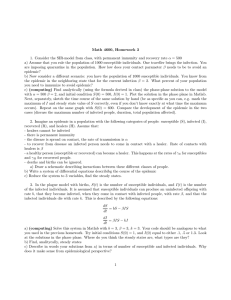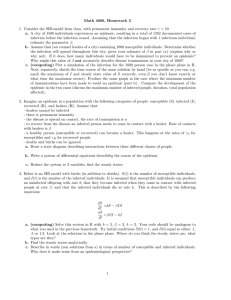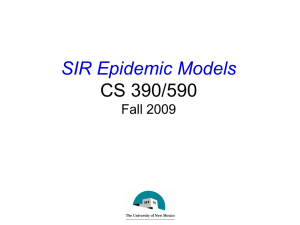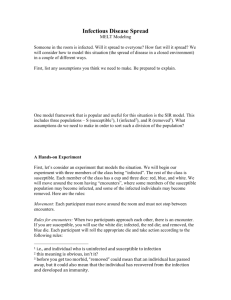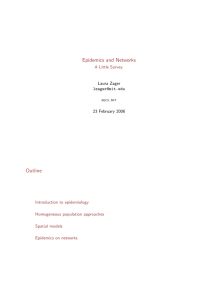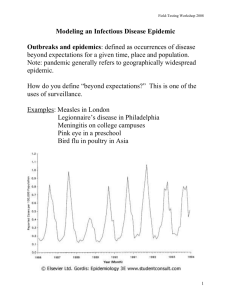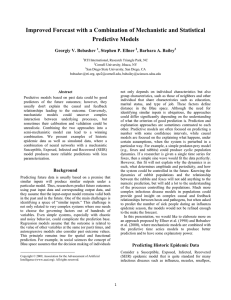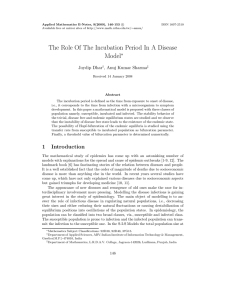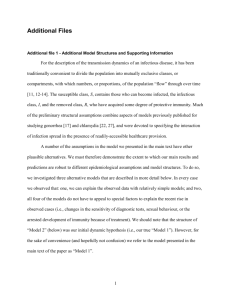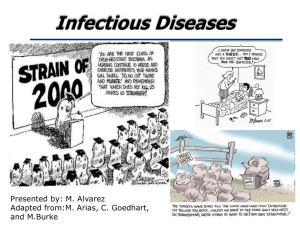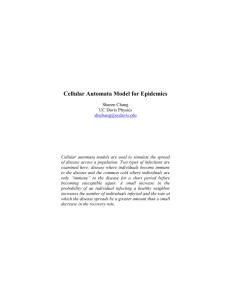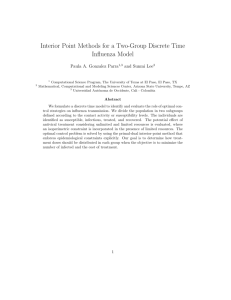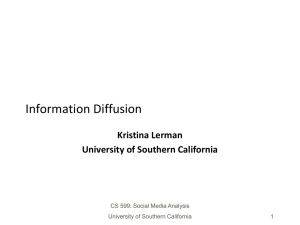Sir model
advertisement
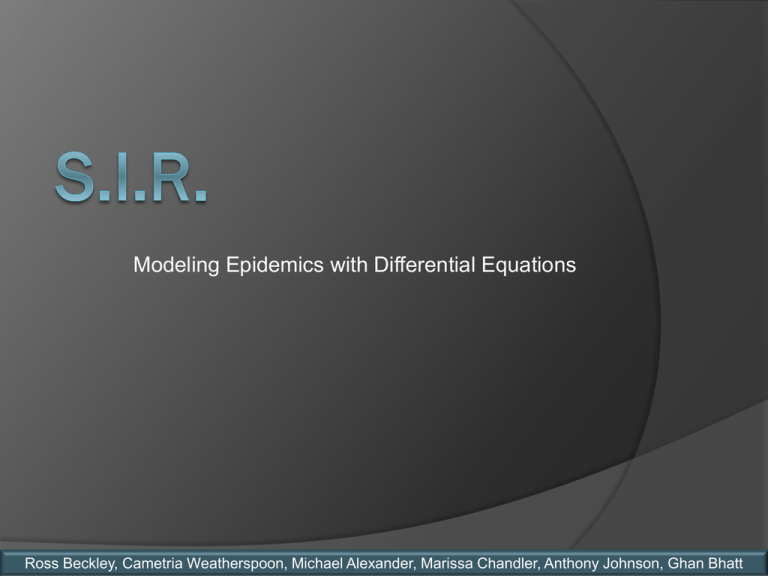
Modeling Epidemics with Differential Equations Ross Beckley, Cametria Weatherspoon, Michael Alexander, Marissa Chandler, Anthony Johnson, Ghan Bhatt The Model Va r i a b l e s & P a r a m e t e r s , A n a l y s i s , Assumptions Sol uti on Techni ques Vacci nati on Bi rth/D eath C onstant Vacci nati on w i th Bi rth/D eath Saturati on of the Suscepti bl e Popul ati on Infecti on D el ay Future of SIR 𝑆+𝐼+𝑅 =1 [S] is the susceptible population [I] is the infected population [R] is the recovered population 1 is the normalized total population in the system The population remains the same size No one is immune to infection Recovered individuals may not be infected again Demographics do not affect probability of infection 𝜕𝑆 𝜕𝑡 = −α𝑆𝐼 [α] is the transmission rate of the disease 𝜕𝐼 𝜕𝑡 = α𝑆𝐼 − β𝐼 [β] is the recovery rate 𝜕𝑅 𝜕𝑡 = β𝐼 The population may only move from being susceptible to infected, infected to recovered: 𝑆→𝐼→𝑅 𝑅0 is the Basic Reproductive Number- the average number of people infected by one person. α𝑆 β = α β Initially, 𝑅0 = The representation for 𝑹𝟎 will change as the model is improved and becomes more developed. [𝑅0 ] is the metric that most easily represents how infectious a disease is, with respect to that disease’s recovery rate. An epidemic occurs if the rate of infection is > 0 α If 𝐼 ′ > 0, and 𝑅0 = β ○ 𝐼 ′ = α𝑆𝐼 − β𝐼 > 0 ○ It follows that an epidemic occurs if 𝑅0 > 1 Moreover, an epidemic occurs if 𝑆 > β α Determine equilibrium solutions for [I’] and [S’]. Equilibrium occurs when [S’] and [I’] are 0: 𝜕𝑆 𝜕𝑡 = −α𝑆𝐼 = 0 𝜕𝐼 𝜕𝑡 = α𝑆𝐼 − β𝐼 = 0 Equilibrium solutions in the form (𝑆1 , 𝐼1 ) and (𝑆2 , 𝐼2 ): ○ 0,0 𝑎𝑛𝑑 β ( , 0) α Compute the Jacobian Transformation: General Form: 𝑓𝑥 𝐽= 𝑔 𝑥 −α𝐼 𝐽= α𝐼 𝑓𝑦 𝑔𝑦 −α𝑆 α𝑆 − β Evaluate the Eigenvalues. Our Jacobian Transformation reveals what the signs of the Eigenvalues will be. A stable solution yields Eigenvalues of signs (-, -) An unstable solution yields Eigenvalues of signs (+,+) An unstable “saddle” yields Eigenvalues of (+,-) Evaluate the Data: Phase portraits are generated via Mathematica. 2.0 1.5 Infected 1.0 0.5 0.0 0.0 0.5 1.0 Susceptible 1.5 2.0 Susceptible Vs. Infected Graph Unstable Solutions deplete the susceptible population There are 2 equilibrium solutions One equilibrium solution is stable, while the other is unstable The Phase Portrait converges to the stable solution, and diverges from the unstable solution Evaluate the Data: Another example of an S vs. I graph with different values of [𝑅0 ]. 𝑹𝟎 12 9 5 2 Typical 𝑅0 Values Flu: 2 Mumps: 5 Pertussis: 9 Measles: 12-18 Herd Immunity assumes that a portion [p] of the population is vaccinated prior to the outbreak of an epidemic. New Equations Accommodating Vaccination: 𝑆 ′ = −α 1 − 𝑝 𝑆𝐼 𝐼 ′ = α 1 − 𝑝 𝑆𝐼 − β𝐼 An outbreak occurs if 𝐼 ′ > 0, or 𝑅0 > 1 1−𝑝 Herd Immunity implies that an epidemic can be prevented if a portion [p] of the population is vaccinated. Epidemic: 𝑅0 > 1 1−𝑝 No Epidemic: 𝑅0 < 1 1−𝑝 Therefore the critical vaccination occurs at 𝑅0 = 𝑝𝑐 = 1 − 1 𝑅0 1 , 1−𝑝𝑐 or ○ In this context, [𝑝𝑐 ] is also known as the bifurcation point. Birth and death is introduced to our model as: The birth and death rate is a constant rate [m] The basic reproduction number is now given by: 𝛼 𝑅0 = 𝛽+𝑚 Disease free equilibrium (𝑆1 , 𝐼1 ) = 1,0 Epidemic equilibrium 𝛽+𝓂 𝓂 (𝑆2 , 𝐼2 )= ( 𝛼 , 𝛼 (𝑅0 − 1) Jacobian matrix 𝐽1 (𝑆1,𝐼1)= 𝐽2 (𝑆2 , 𝐼2 ) = −𝑚 0 −𝑎 𝑎−𝐵−𝑚 −𝑚 − 𝑅𝑜 − 1 𝑚 𝑅𝑜 − 1 𝑚 −𝑎 𝑅𝑜 0 New Assumptions A portion [p] of the new born population has the vaccination, while others will enter the population susceptible to infection. The birth and death rate is a constant rate [m] Parameters 𝑝 = % 𝑜𝑓 𝑛𝑒𝑤𝑏𝑜𝑟𝑛 𝑝𝑜𝑝𝑢𝑙𝑎𝑡𝑖𝑜𝑛 𝑣𝑎𝑐𝑐𝑖𝑛𝑎𝑡𝑒𝑑 𝑚 = 𝑟𝑎𝑡𝑒 𝑜𝑓 𝑛𝑒𝑤𝑏𝑜𝑟𝑛 𝑎𝑛𝑑 𝑑𝑒𝑎𝑡ℎ 𝑟𝑎𝑡𝑒 Susceptible 𝑆′ = 1 − 𝑝 𝑚 − α𝐼 + 𝑚 𝑠 Infected I′ = α𝑠𝐼 − 𝛽𝐼 − 𝑚𝐼 𝑅0 = The initial rate at which a disease is spread when one 𝛼 infected enters into the population. 𝑅0 = 𝛽+𝑚 p = number of newborn with vaccination 𝛼 1−𝑝 −𝛽−𝑚 <1 𝛼 1−𝑝 <𝛽+𝑚 1−𝑝 < 1−𝑝 < 𝑅0 = 1 1−𝑝 𝑅0 = 1 > 1−𝑝 <1 1 𝛽+𝑚 𝛼 1 𝑅0 Unlikely Epidemic Probable Epidemic 𝑝𝑐 = critical vaccination value 1 𝑝𝑐 = 1 − 𝑅0 For measles, the accepted value for 𝑅0 = 18, therefore to stymy the epidemic, we must vaccinate 94.5% of the population. Susceptible Vs. Infected • Non epidemic 𝑅0 < 1 p > 95 % 1.0 0.8 Infected 0.6 0.4 0.2 0.0 0.0 0.2 0.4 0.6 Susceptible 0.8 1.0 Susceptible Vs. Infected 2.0 1.5 Infected • Epidemic 𝑅0 > 1 𝑝 < 95 % 1.0 0.5 0.0 0.0 0.5 1.0 Susceptible 1.5 2.0 Constant Vaccination Moving Towards Disease Free New Assumption We introduce a population that is not constant. S+I+R≠1 𝑟 is a growth rate of the susceptible K is represented as the capacity of the susceptible population. The Equations Susceptible 𝑠 𝑘 S′ = 𝑟𝑠(1 − )−𝛼sI 𝑟 = growth rate of birth 𝑘 = capacity of susceptible population Infected I ′ = 𝛼𝑠𝐼 − 𝛽𝐼 − 𝑚𝐼 𝑚= death rate People in the susceptible group carry the disease, but become infectious at a later time. [r] is the rate of susceptible population growth. [k] is the maximum saturation that S(t) may achieve. [T] is the length of time to become infectious. [σ] is the constant of Mass-Action Kinetic Law. The constant rate at which humans interact with one another “Saturation factor that measures inhibitory effect” 𝑆+𝐼+𝑅 1 Saturation remains in the Delay model. The population is not constant; birth and death occur. 𝑆 𝐼 ′ ′ = 𝑟𝑆 = 𝑟𝑆 2 − 𝐾 α𝑆𝐼(𝑡−𝑇) 1+σ𝑆 𝛼𝑆𝐼 𝑡−𝑇 − 1+σ𝑆 − 𝑚𝐼 − β𝐼 U.S. Center for Disease Control Eliminate Assumptions Population Density Age Gender Emigration and Immigration Economics Race
